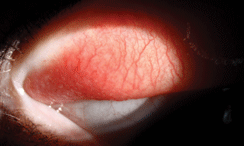 Contact lens solutions can cause a plethora of ocular surface reactions that can range anywhere from the blatantly obvious to the surprisingly subtle.
Contact lens solutions can cause a plethora of ocular surface reactions that can range anywhere from the blatantly obvious to the surprisingly subtle.
Regardless of the presentation, however, solution-related problems can negatively affect contact lens wear and potentially lead to contact lens dropout.
The Big Four
Although many potential complications exist, these four are the most commonly seen in practice.
• Toxic keratopathy is observed when a toxic substance, such as contact lens cleaner, peroxide or preservative, is placed in direct contact with the eye. When caused by lens cleaners or 3% hydrogen peroxide, the adverse effect is dramatic and can be observed immediately.
Contact lens cleaners contain surfactants, such as alkyl ether sulfate or isopropyl alcohol, which are effective in removing contaminants from the lens surface, but, depending on the concentration, may irritate the ocular surface.
Both isopropyl alcohol and hydrogen peroxide are broad-spectrum microbiocidal agents, and effectively kill 80% of present bacterial, viral and fungal contaminates within just one minute of contact.
Each of these agents work by rapidly damaging cell membranes and causing cell lysis. Therefore, if either of these agents directly contact the corneal surface, the result is often intense pain and sloughing of the epithelium.
• Solution-induced corneal staining (SICS), a far less dramatic presentation of toxic keratopathy, occurs through the uptake and release patterns of the lens/solution combination. The phospholipid membrane is disrupted as the biocide is released back to the cornea, which can be observed as corneal staining.

| |
|
Figure 1. Tarsal hyperemia and papillary response from a solution allergy.
|
The amount of staining depends on biocide concentration, as well as the length of contact. Unfortunately, if the contact lens is not removed, and fluorescein is not instilled into the eye during progress check, the subtle signs of SICS can be frequently overlooked.
Often, these signs are also missed due to timing. SICS onsets several hours after lens insertion and then repairs itself as the day progresses.
As a result, the window of opportunity to observe this condition is very small. Regardless of whether SICS is observed, the symptoms may be progressive and present as increasing dryness and irritation.
• Allergic reaction. Signs of contact lens solution allergies can include hyperemia and fine papillary changes of the tarsal plate, conjunctival hyperemia, chemosis and limbitis.
These complications can manifest in varying degrees. For example, patients may present with a sense of irritation or outright itching. In more severe cases, there have been reports of systemic allergy from contact lens solutions.1
If a patient has a suspected solution allergy, patch testing may be appropriate due to the cross over into other products, such as personal hygiene products, cleaners and pool disinfectants.
• Dry eye. Contact lens solutions interact not only with the ocular surface, but possibly with the lens itself. The lens/solution affinity is governed by many factors, including lens material, surfactant/biocide size and composition.
Each lens/solution combination will affect protein and lipid deposition. Deposits on the lens are notorious for causing end-of-day discomfort or dryness.
If a patient presents with dryness as a result of their solution, changing to a different solution, switching to daily disposable lenses or adding a separate surfactant cleaner can help reduce deposits and increase comfort.
The Missing Link?
Solutions are a complex yet incredibly important part of the contact lens comfort and safety equation.
While some problems caused by solutions are obvious, others manifest in subtle ways that are difficult to spot. This leads to dissatisfaction with lens wear and increases dropout.
It is important to always keep the solution in mind—the “solution” to your problems may be simpler than you think.
1. Cressey B. Systemic allergic dermatitis of the lips resulting from allergy to an antimicrobial agent in a contact lens disinfecting solution. Contact Dermatitis. 2012;67(4):239-40.


